Study on the Influence of Casing Surface Morphology on the Plugging Performance of Downhole CO2 Plugging with Sn58Bi
Abstract
:1. Introduction
2. Materials and Methods
2.1. Sn58Bi Alloy Plugging Casing Method
- Low melting point: Its melting process requires low energy that does not affect the strength of the casing body;
- Micro-expansion: This alloy expands in volume (similar to water freezing) when it solidifies from the liquid state to the solid state;
- Corrosion resistance: The alloy is able to resist corrosion, especially H2S and CO2;
- High density: Due to the high density of the alloy, other impurities in the wellbore float to the top during the melting and solidification process, assisting in forming a pure alloy plug for seal integrity;
- High mobility in liquid-state alloys is capable of completing seals in tiny gaps and irregular shapes.
- High stability of sealing: Sn58Bi alloy itself has the characteristics of denseness, corrosion resistance, high strength, etc., and the alloy plug formed is able to withstand the interference of most unfavorable factors downhole;
- Compared with the curing time during the molding process of cement plugs, the alloy plug can complete the sealing function after cooling naturally at the bottom of the well, and the operation time is greatly reduced;
- After turning threads in the casing, the sealing path per unit sealing length is increased and gas sealing performance is improved, while the threaded structure increases the axial pressure-bearing capacity of the alloy plug.
2.2. Casing Material
2.3. Alloy Plug Sample Molding Setup
- Install a high-temperature-resistant rubber plug at the bottom of the casing to prevent the molten state alloy from leaking out from under the casing;
- Calculate the weight of alloy required for the corresponding length of alloy plug and place the weight of alloy in the alloy casing;
- Place the casing with alloy fragments in the heating unit;
- Turn on the temperature control box, set the heating temperature at 250 °C, and heat for 2 h to ensure that the alloy is fully molten;
- Close the heating setup. The alloy plug is allowed to stand for 6 h so that the alloy plug cools to room temperature;
- Remove the casing with the alloy plug sample and pull out the rubber plug.
2.4. Gas Sealing Performance Test Setup
3. Experiments and Processes
3.1. Gas Sealing Performance Test
3.2. Analysis of Gas Leakage Sources and Surface Microstructure
4. Experimental Results
4.1. Influence of Ambient Temperature and Threaded Groove on the Gas Sealing Performance of Alloy Plug
4.1.1. The Influence of Ambient Temperature on Gas Sealing Performance
4.1.2. The Influence of Threaded Groove on Gas Sealing Performance
4.1.3. The Influence of Length-to-Diameter Ratio and Roughness on Gas Sealing
Performance of Alloy Plug
5. Conclusions
- (1)
- The sealing performance of the alloy plug is relatively affected by the ambient temperature. With the increase in ambient temperature, the radial stress inside the alloy plug–casing interface rises, the alloy combines more tightly with the inner surface of the casing, and the gas sealing performance of the alloy plug appears to be significantly increased.
- (2)
- The threaded groove on the inner surface of the casing has a significant effect on the gas sealing performance of the alloy plug. Under the condition of the same length-to-diameter ratio of the alloy plugs, the alloy plugs of the threaded casing have a significant increase in gas sealing performance due to the increase in the area of the alloy–casing interface. As the pitch decreases, the degree of gas flow path zigzagging increases, and the gas sealing performance of the alloy plug increases.
- (3)
- The gas sealing performance of alloy plugs showed an obvious linear positive correlation with their length-to-diameter ratio. The gas sealing performance of alloy plugs is less affected by the roughness of the inner surface of the casing. Relying only on the radial force generated by the micro-expansion during the molding process of the alloy plug, the alloy is not sufficient to fully fill the micron-sized grooves.
- (4)
- When the casing was processed through internal threaded grooves, the threaded grooves should be designed at the lower section position of the target area. The gravity force generated by the alloy above the threaded grooves can further increase the degree of filling of the molten alloy with the threaded portion, and this design method can further improve the gas sealing performance of the threaded alloy plug.
Author Contributions
Funding
Institutional Review Board Statement
Informed Consent Statement
Data Availability Statement
Acknowledgments
Conflicts of Interest
Nomenclature
| Axial stress at the end of the plug (MPa). | |
| The normal pitch angle. | |
| The pitch (mm). | |
| The path length of the single thread (mm). | |
| The length of the threaded area (mm). | |
| The total length of the path on the axial surface of the alloy casing (mm). | |
| ccus | Carbon Capture, Utilization, and Storage. |
References
- Li, H.F.; Wang, Q. Study on utilization and geological storage of CO2 in CCUS. Mod. Chem. Ind. 2022, 42, 86–90+95. [Google Scholar] [CrossRef]
- Liu, F.; Sheng, Z.; Li, J.; Yan, S.; Zhu, R. Estimation of Carbon Dioxide Storage Capacity of Depleted Gas Reservoirs in X Sag. Offshore Oil 2023, 43, 13–17. [Google Scholar] [CrossRef]
- Liu, Z.; Gao, M.; Zhang, X.; Liang, Y.; Guo, Y.; Liu, W.; Bao, J. CCUS and CO2 injection field application in abroad and China: Status and progress. Geoenergy Sci. Eng. 2023, 229, 212011. [Google Scholar] [CrossRef]
- Wang, D.; Li, J.; Liu, P.; Liu, X.; Lu, W.; Lian, Z. Simulation study of sealing integrity in abandoned wells within CO2 sequestration block. Drill. Fluid Complet. Fluid 2023, 40, 384–390. [Google Scholar] [CrossRef]
- Saasen, A.; Wold, S.; Ribesen, B.T.; Tran, T.N.; Huse, A.; Rygg, V.; Grannes, I.; Svindland, A. Permanent abandonment of a North sea well using unconsolidated well plugging material. SPE Drill. Complet. 2011, 26, 371–375. [Google Scholar] [CrossRef]
- Reddy, B.R.; Xu, Y.; Ravi, K.; Gray, D.; Pattillo, P.D. Cement-Shrinkage Measurement in Oilwell Cementing—A Comparative Study of Laboratory Methods and Procedures. SPE Drill. Complet. 2009, 24, 104–114. [Google Scholar] [CrossRef]
- Gong, P.; Fu, H.; He, D.; Wu, Y.; Mei, K.; Zhang, C.; He, X.; Liu, T.; Li, S.; Cheng, X. Novel material to enhance the integrity of CCUS cement sheath: Exploration and application of calcium aluminate cement. Gas Sci. Eng. 2024, 124, 205247. [Google Scholar] [CrossRef]
- Carragher, P.; Fulks, J. A New Look at Sealing with Bismuth and Thermite. In Proceedings of the SPE Annual Technical Conference and Exhibition, Dallas, TX, USA, 24–26 September 2018. [Google Scholar] [CrossRef]
- Carragher, P.; Fulks, J. Rigless Abandonment with Bismuth and Thermite. In Proceedings of the SPE Symposium: Decommissioning and Abandonment, Kuala Lumpur, Malaysia, 3–4 December 2018. [Google Scholar] [CrossRef]
- Thorstensen, E.; Vadset, K.; Straume, M.K.; Delabroy, L.; Abdelal, G.; Carragher, P.; Fulks, J.; Mason, D.L. Bismuth Plugs Used to Cap All Wells During the Final Phase of the Valhall DP Abandonment Campaign, Offshore Norway. In Proceedings of the OTC Offshore Technology Conference, Houston, TX, USA, 2–5 May 2022. [Google Scholar] [CrossRef]
- Zhang, H.; Ramakrishnan, T.S.; Elias, Q.K.; Perez, A., Jr. Evaluation of Bismuth-Tin Alloy for Well Plug and Abandonment. SPE Prod. Oper. 2020, 35, 111–124. [Google Scholar] [CrossRef]
- Lewaa, H.; Elahifar, B.; Sangesland, S. The sealing behavior of bismuth-based metal plugs. In Proceedings of the ASME 2023 42nd International Conference on Ocean, Offshore and Arctic Engineering OMAE2023, Melbourne, Australia, 11–16 June 2023. [Google Scholar] [CrossRef]
- Liang, B.; Hu, P.; Nie, Y.; Feng, G.; Zhou, J.; Bai, Y.; Niu, G.; Niu, W.; Zhou, Y. Experimental Study on the Influence of Temperature and Loading Rate on the Mechanical Properties of Sn-58Bi Alloy. Funct. Mater. 2021, 52, 1145–1155. [Google Scholar] [CrossRef]
- Zhang, H.; Ramakrishnan, T.S.; Elkady, Y.M.; Feng, Y.; Elias, Q.K. Comparative Evaluation of Bismuth-Silver and Bismuth-Tin Alloys for Plug and Abandonment. SPE Drill. Complet. 2021, 36, 368–382. [Google Scholar] [CrossRef]
- Abdelal, G.F.; Robotham, A.; Carragher, P. Numerical simulation of a patent technology for sealing of deep-sea oil wells using nonlinear finite element method. J. Pet. Sci. Eng. 2015, 133, 192–200. [Google Scholar] [CrossRef]
- Schuppert, A.; Polotzek, K.; Schmitt, J.; Busse, R.; Karschau, J.; Karagiannidis, C. A Full Laboratory Study on the Physical and Mechanical Properties of a Bismuth Plug. In Proceedings of the IADC/SPE International Drilling Conference and Exhibition, Stavanger, Norway, 7–9 March 2023. [Google Scholar] [CrossRef]
- Chen, X. Study on the Microstructure and Performance of Sn-Bi Based Solder. Ph.D. Thesis, Southeast University, Nanjing, China, 2017. Available online: https://kns.cnki.net/kcms2/article/abstract?v=KqXyGY4RJv0myydx0WA2mZoh-9SKB4apI9tsFEcdzMl0Vt4MBMbTyfo_yrtZfV-5x2xDewj7341fpY2PG-ZZpPu4Dq8n8YqoB0fYmsPPPTOpGMdflX9w0YHpxBHTiEw0bKhWpZ0leylQc5eiZSQfoKtAa-QE5hXcXNgzQFTX9n40IcYlfNRmwJrbJ3CSZFxD&uniplatform=NZKPT&language=CHS (accessed on 28 September 2024).
- Li, X.B. Threads and Their Couplings; China Planning Press: Beijing, China, 2004. [Google Scholar]
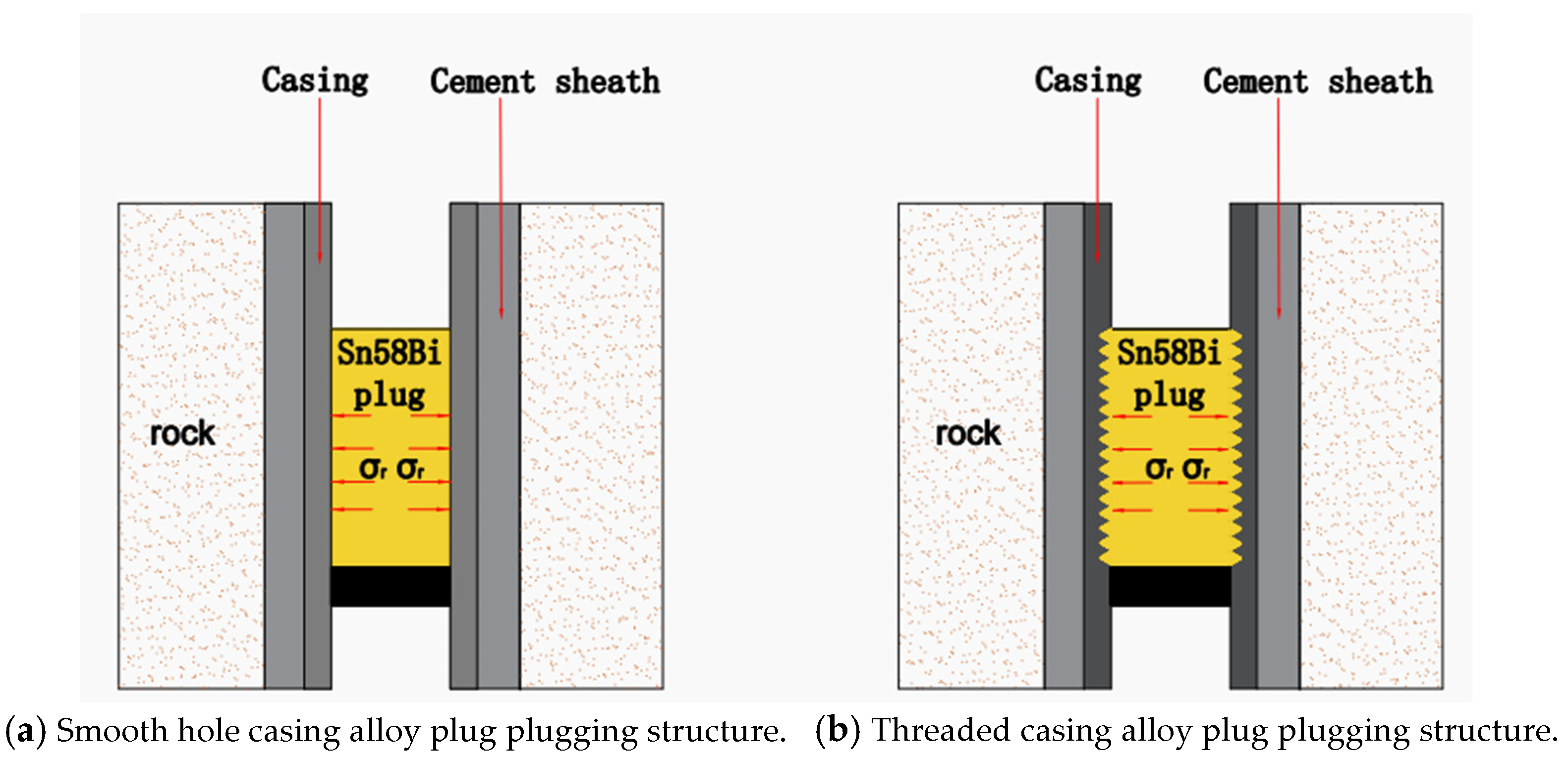
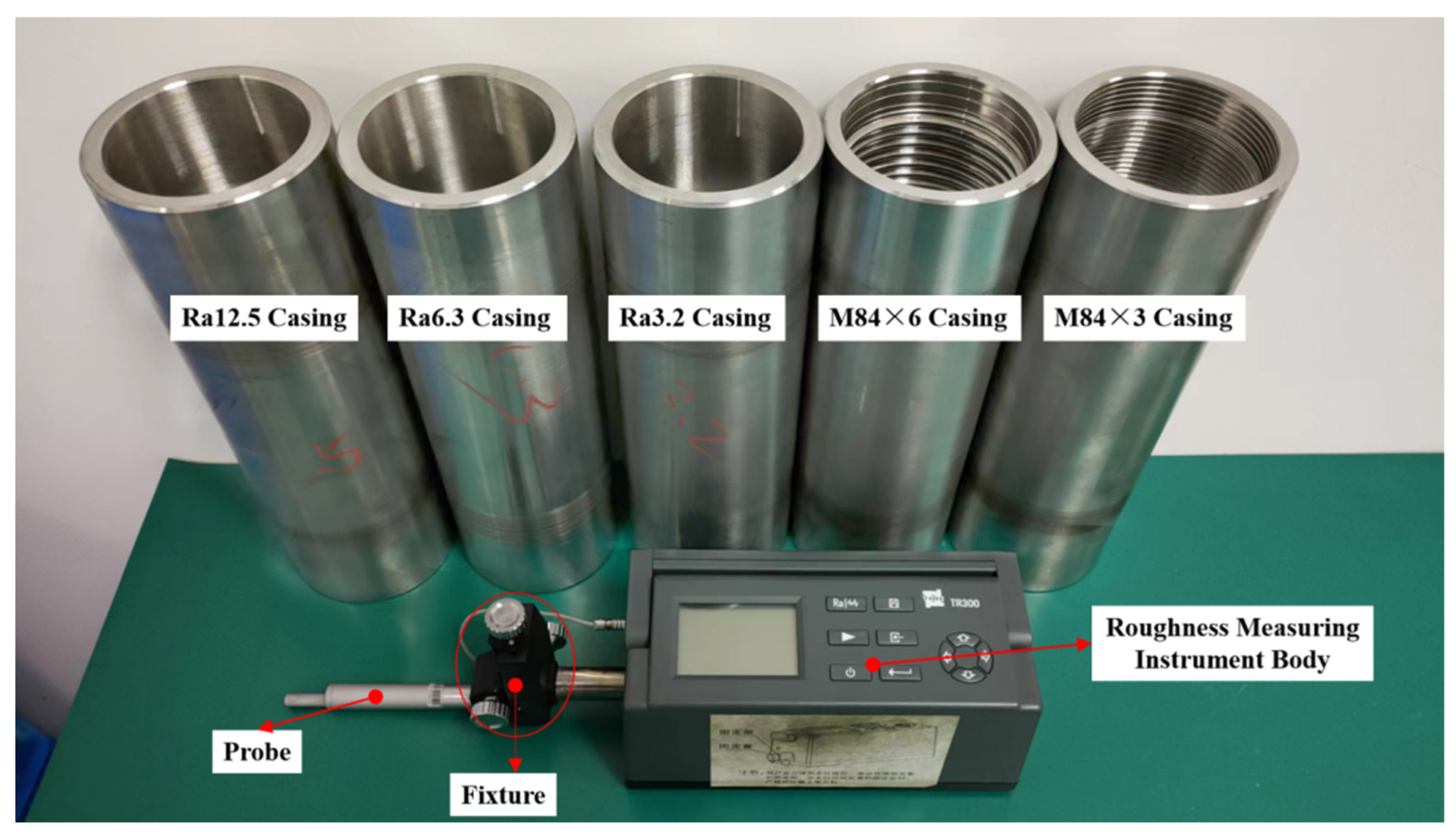
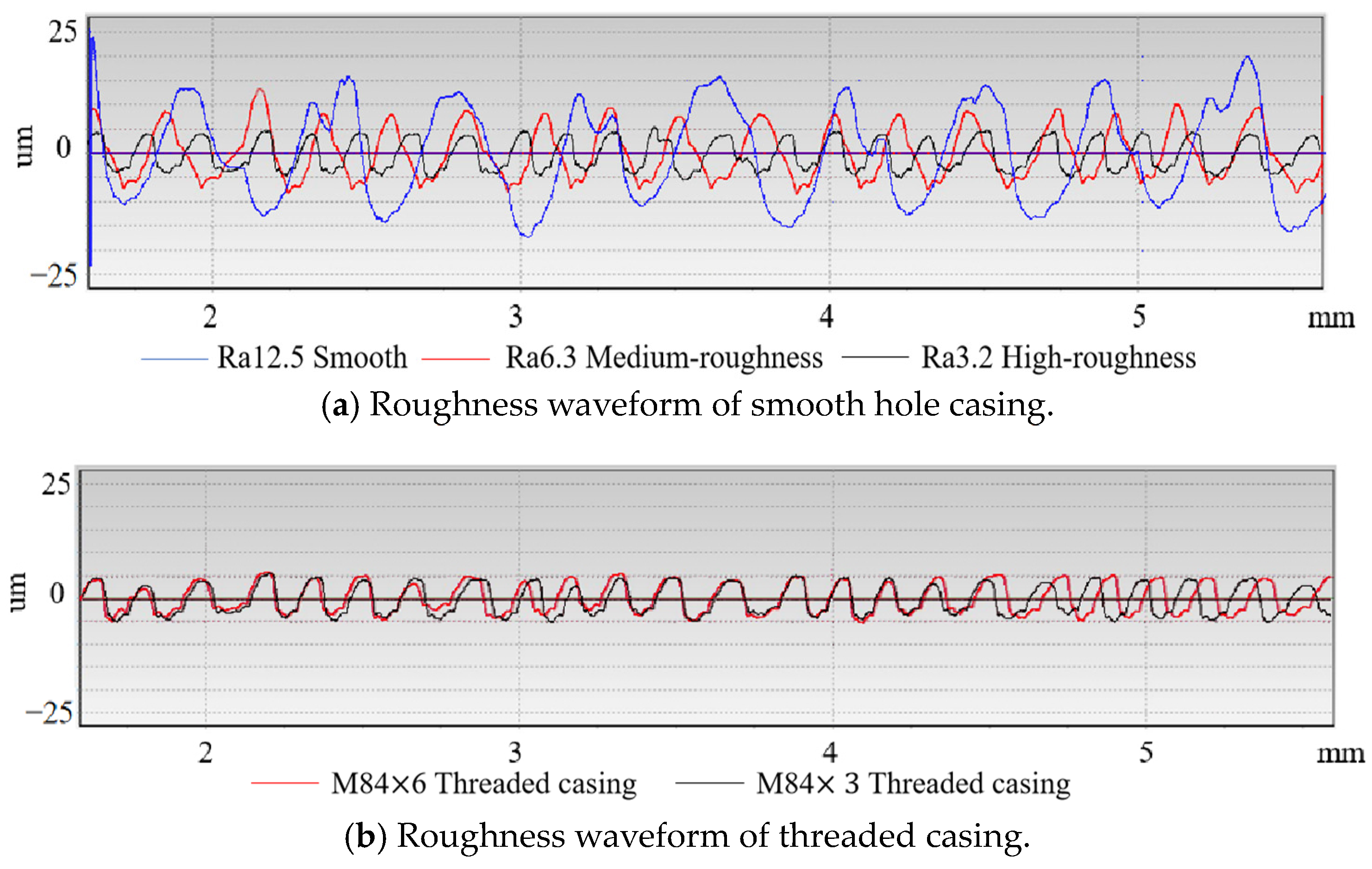

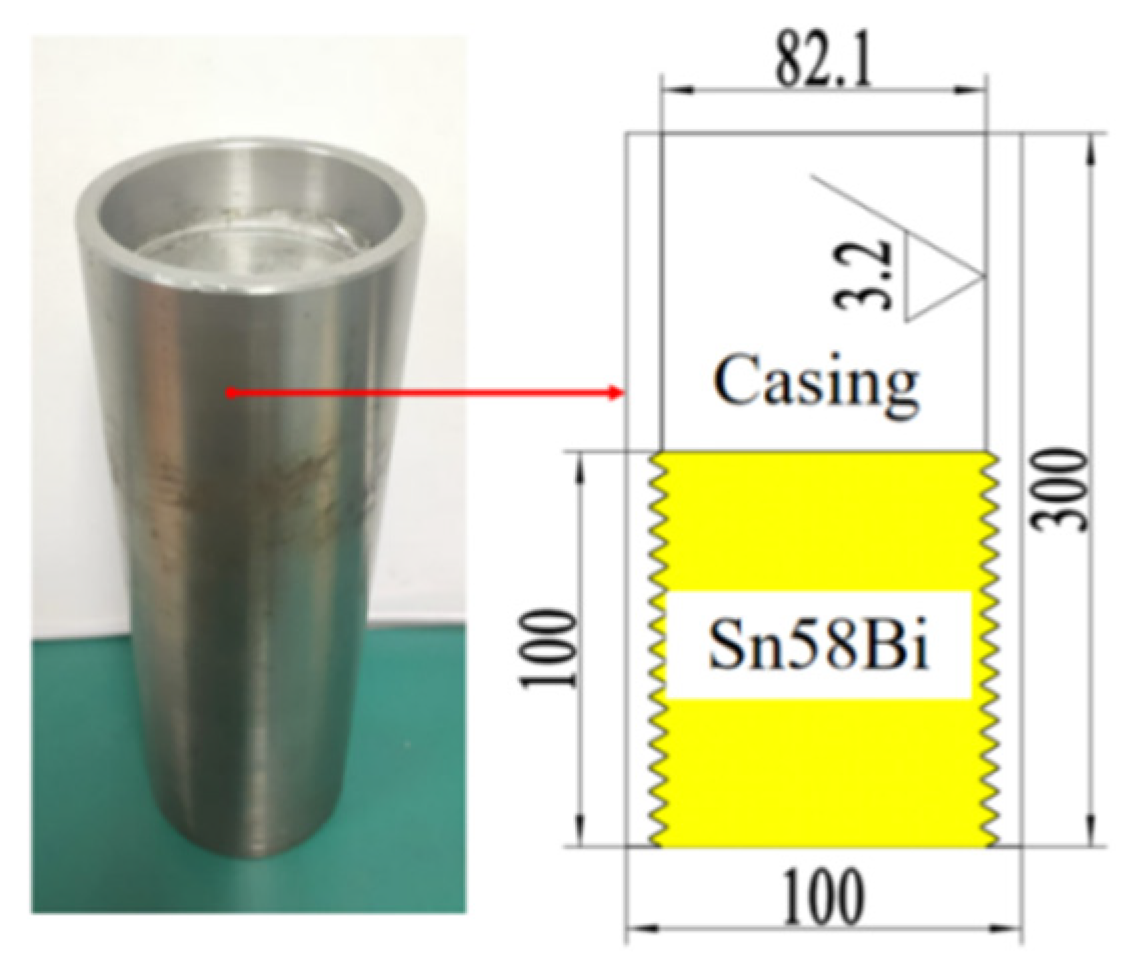

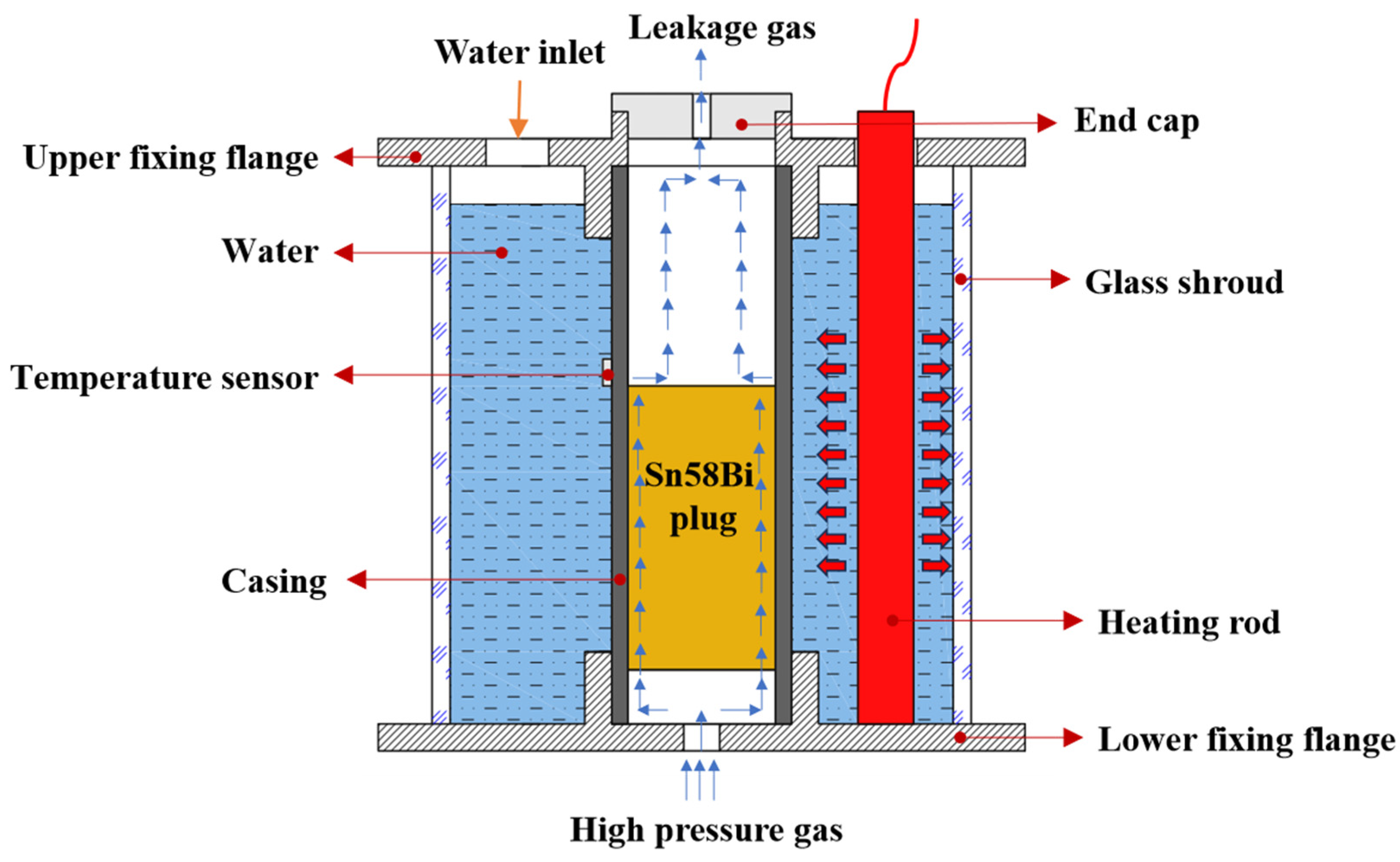
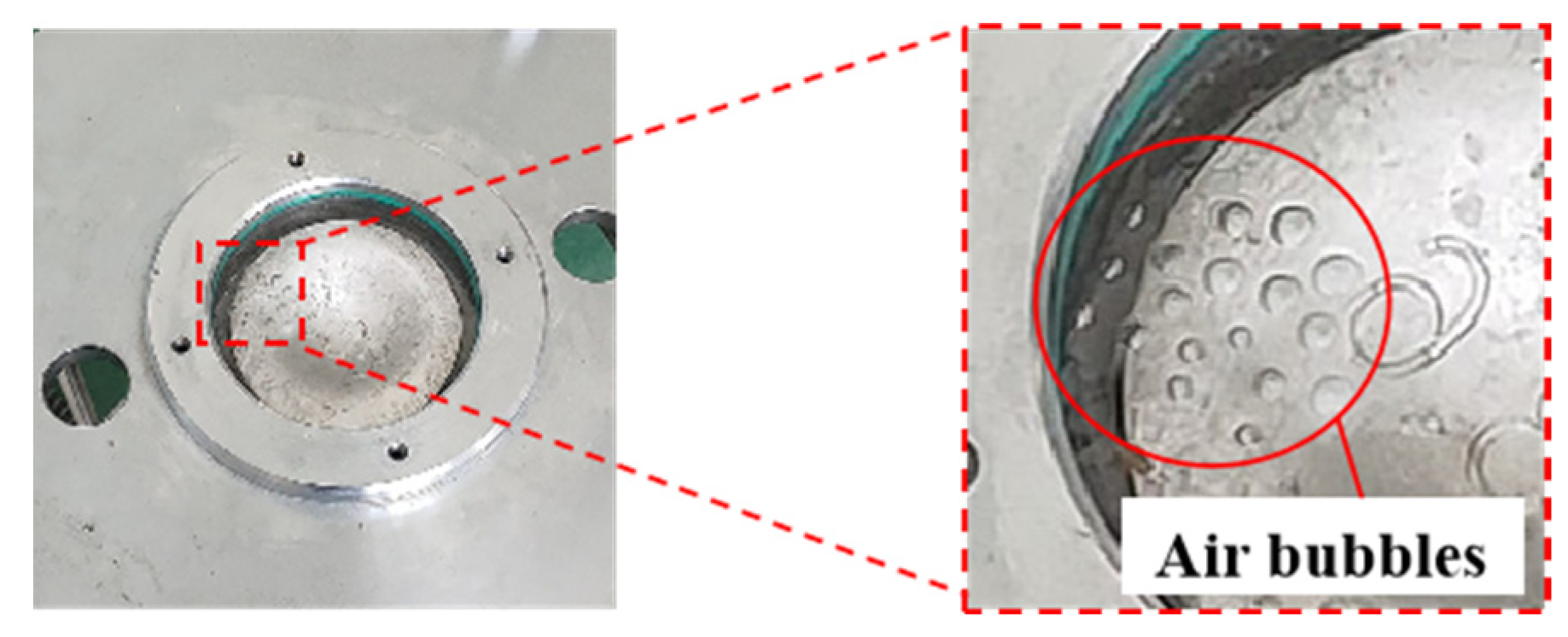



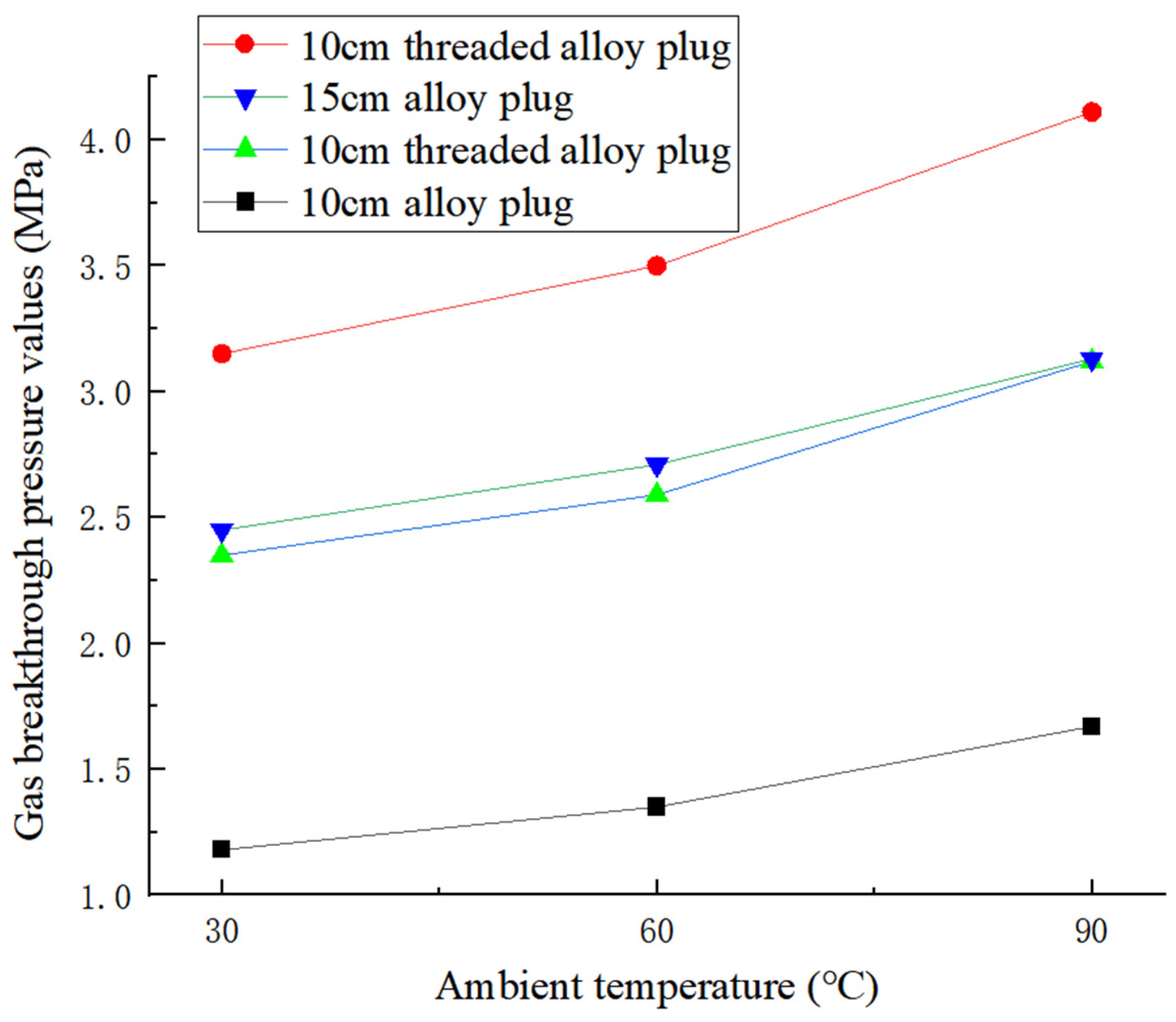
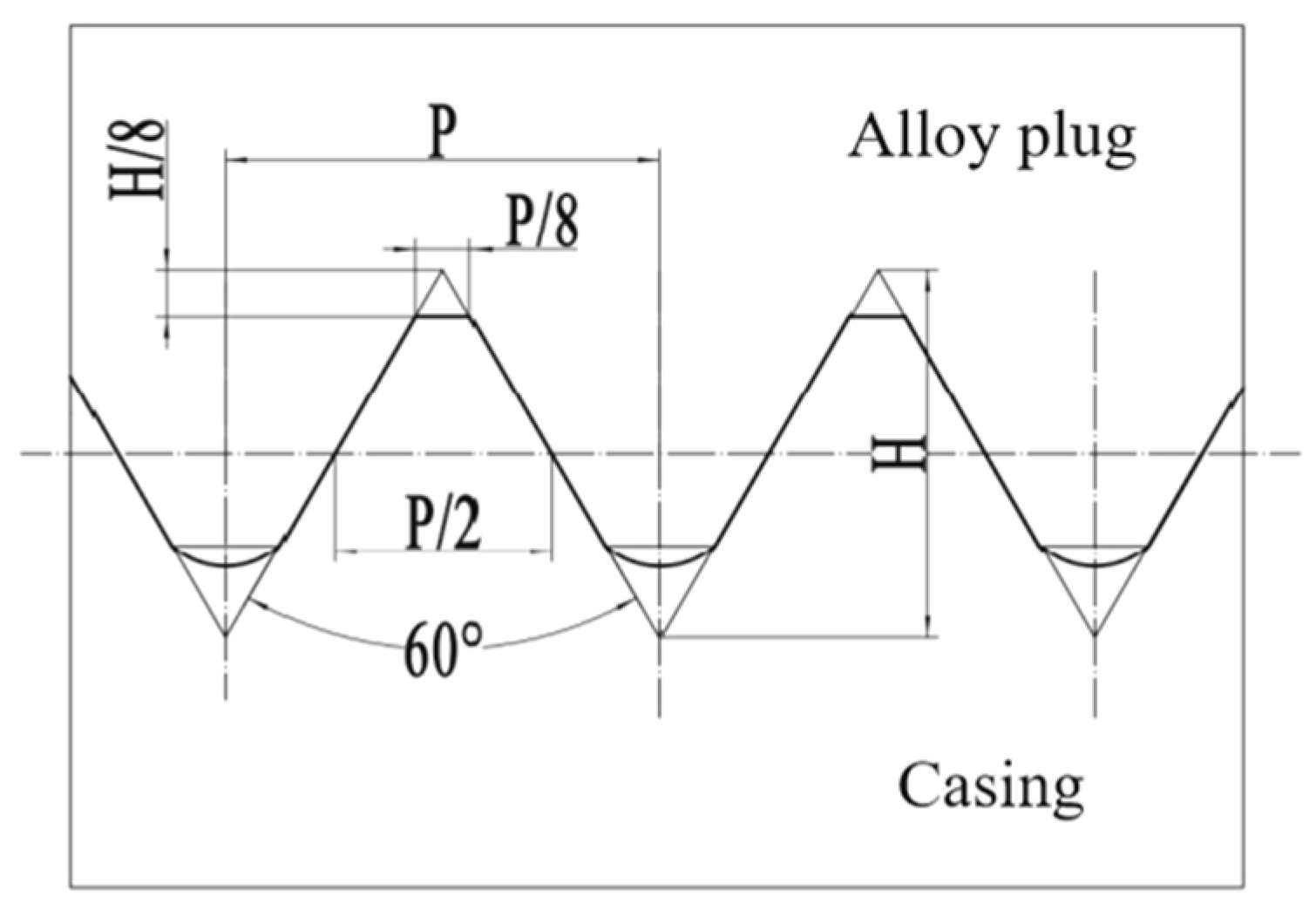
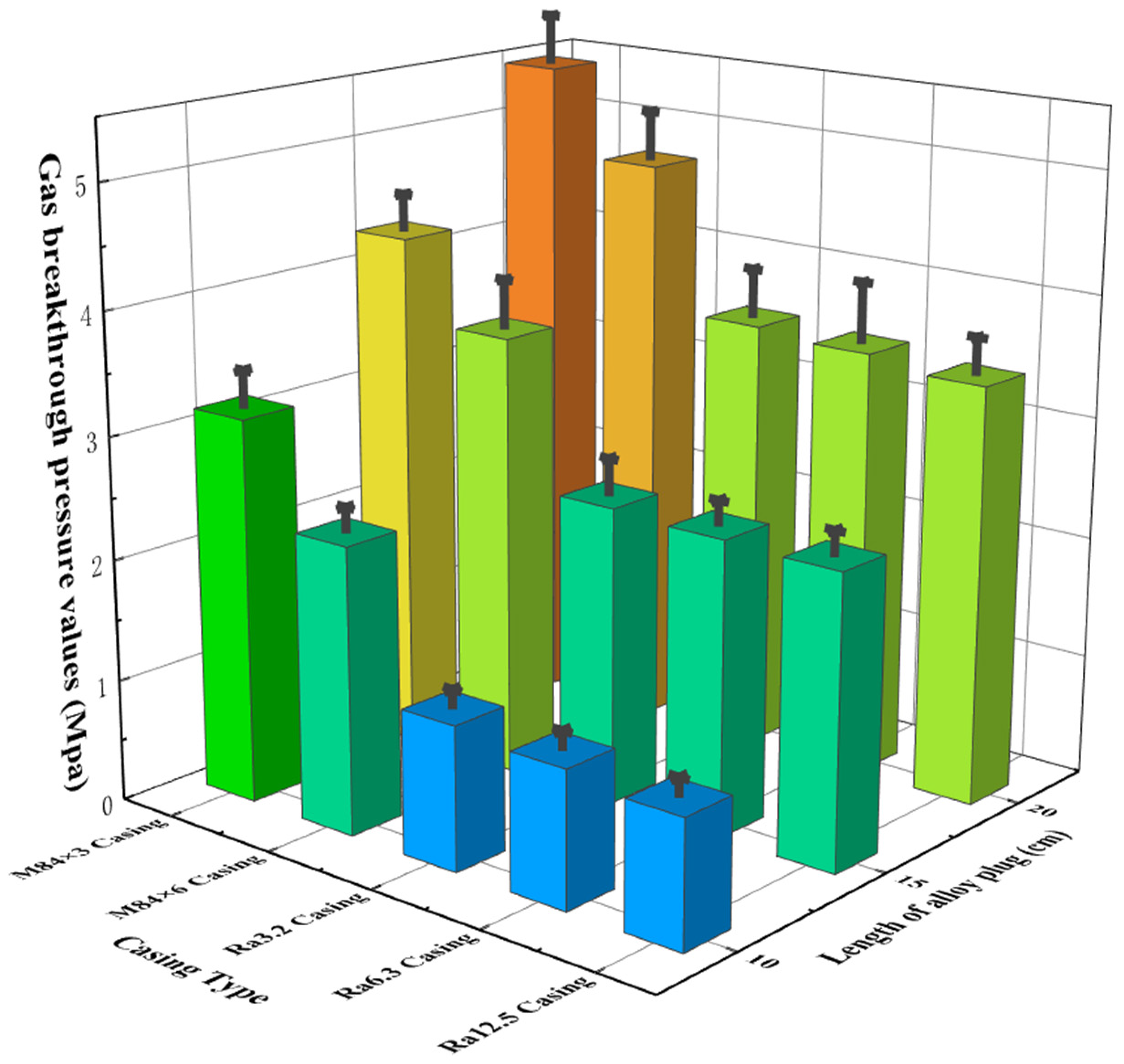
| Properties | Melting Point (°C) | Surface Tension at 155 °C (mPa·s) | Thermal Expansion Coefficient (°C−1) | Volume Change (from Liquid to Solid) | Density at 21 °C (g/cm3) |
|---|---|---|---|---|---|
| Value | 138 | 438 | 1.5 × 10−7 | +0.77% | 8.72 |
| Casing Type | Roughness | Nominal Diameter (mm) | Pitch of Spiral (mm) | Thread Length (mm) |
|---|---|---|---|---|
| Smooth casing | Ra3.2 | - | - | - |
| Medium-roughness casing | Ra6.3 | - | - | - |
| High-roughness casing | Ra12.5 | - | - | - |
| Threaded casing | Ra3.2 | 84 | 3 | 100 |
| Threaded casing | Ra3.2 | 84 | 6 | 100 |
Disclaimer/Publisher’s Note: The statements, opinions and data contained in all publications are solely those of the individual author(s) and contributor(s) and not of MDPI and/or the editor(s). MDPI and/or the editor(s) disclaim responsibility for any injury to people or property resulting from any ideas, methods, instructions or products referred to in the content. |
© 2024 by the authors. Licensee MDPI, Basel, Switzerland. This article is an open access article distributed under the terms and conditions of the Creative Commons Attribution (CC BY) license (https://creativecommons.org/licenses/by/4.0/).
Share and Cite
Zha, C.; Cui, T.; Wang, W.; Liu, G. Study on the Influence of Casing Surface Morphology on the Plugging Performance of Downhole CO2 Plugging with Sn58Bi. Appl. Sci. 2024, 14, 9249. https://doi.org/10.3390/app14209249
Zha C, Cui T, Wang W, Liu G. Study on the Influence of Casing Surface Morphology on the Plugging Performance of Downhole CO2 Plugging with Sn58Bi. Applied Sciences. 2024; 14(20):9249. https://doi.org/10.3390/app14209249
Chicago/Turabian StyleZha, Chunqing, Tengfei Cui, Wei Wang, and Gonghui Liu. 2024. "Study on the Influence of Casing Surface Morphology on the Plugging Performance of Downhole CO2 Plugging with Sn58Bi" Applied Sciences 14, no. 20: 9249. https://doi.org/10.3390/app14209249
APA StyleZha, C., Cui, T., Wang, W., & Liu, G. (2024). Study on the Influence of Casing Surface Morphology on the Plugging Performance of Downhole CO2 Plugging with Sn58Bi. Applied Sciences, 14(20), 9249. https://doi.org/10.3390/app14209249





